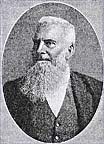Charles Steedman was born in London, England, on July 9, 1830, into a Dickensian world of gas-lit streets and horse-drawn carriages. He died in North Williamstown, Victoria, Australia, on June 14, 1901. Steedman was a champion swimmer in England and Australia, two countries more than 15,000 miles apart-an unusual acievement in the mid-19th century.
He was self-educated and excelled at everything he set out to do. He began as a map maker, colouring maps at the age of 11, an intricate task for the most seasoned artisans. Two years later, he was a chemist's assistant. At 14, still anxious to learn more skills, he apprenticed to a cabinet maker; he also attended evening classes to learn grammar and mathematics.
At 19, he became a piano-maker, where his new-found knowledge of mathematics enabled accurate measuring and fitting of the spruce sound board. So successful was he in his new craft that he was said to be "proud at having to pay income tax," a fact that enabled him to vote. (At the time, the so-called "working classesÓ were not entitled to sufferage, unless they earned enough to be taxed.)
 Charles Steedman, 10 years before he died at the age of 70
Charles Steedman, 10 years before he died at the age of 70 Steedman emigrated to Australia in 1854, and became swimming's first internationalist when he shared England's more advanced knowledge of the sport with his new countrymen, became champion of Victoria, and there published the first book on speed swimming.
Steedman journeyed to Australia in July 1854 to "see something of the world," and arrived two months later in Port Phillip Bay after a voyage attended by hardship, discomfort, and danger. Most of the time was spent in the latitudes of "the roaring fortiesÓ where the waves were terrifying and said to be the highest in the world.
Passenger accomodation was divided into six-feet-square berths, four to a berth, divided by wooden partitions, only one-foot high, which gave no privacy. In congested conditions Steedman endured many monotonous weeks at sea. Dining arrangements were poor; the ship supplied and cooked the food, such as it was, but tables, chairs, cutlery, and plates were not provided.
Steedman's arrival in Australia caused considerable interest among local swimmers because he was the swimming champion of England. At the age of 24, Steedman was already an accomplished, knowledgeable, and articulate man who passed on detailed accounts of swimming techniques in his native land to his new-found friends.
Steedman, a pragmatist by nature, thought it important to have a full-time job, and soon he was earning his living as a skilled piano maker. Always seeking to advance himself, Steedman learned Latin and Greek and became a schoolmaster as well as a journalist.
In Melbourne in 1867, now a well-known and respected member of the young colony, Steedman published his landmark Manual of Swimming, a book destined to become known as the first important text of the modern era.